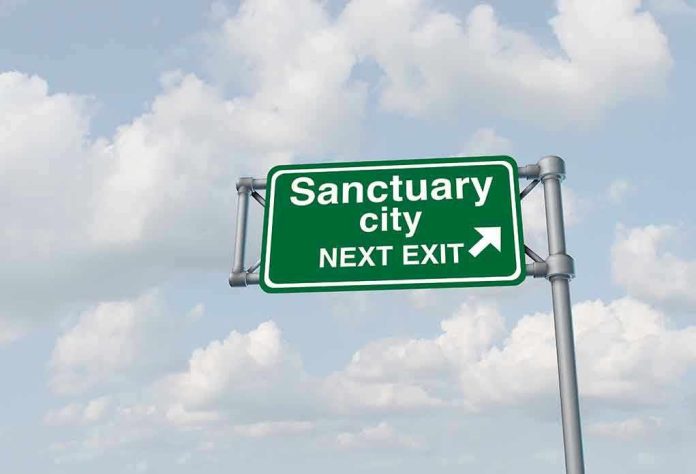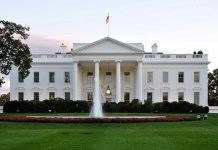
President Trump’s sweeping immigration crackdown is colliding with federal courts, as a judge bars the administration from cutting funds to dozens of sanctuary cities—spotlighting the latest battle over states’ rights and the limits of executive power.
Story Snapshot
- A federal judge has blocked the Trump administration’s attempt to withhold funding from 34 sanctuary cities and counties over their immigration policies.
- Trump’s 2025 agenda aggressively targets illegal immigration, including expanded detention, local enforcement mandates, and threats to sanctuary jurisdictions.
- Legal battles are testing the constitutional limits of executive authority and federal power over local governments.
- Conservative leaders see the ruling as judicial overreach, raising alarms about continued attacks on state sovereignty and law-and-order priorities.
Federal Court Blocks Funding Cuts to Sanctuary Cities
A federal judge’s recent decision has halted the Trump administration’s effort to block federal funding from 34 cities and counties that maintain sanctuary policies. The administration had threatened to withhold critical grants from local governments that do not fully cooperate with federal immigration enforcement. This ruling represents a significant blow to President Trump’s drive to pressure localities into compliance, highlighting the ongoing tension between federal authority and local self-determination regarding immigration enforcement.
This court intervention comes as the Trump administration pursues its most aggressive immigration agenda to date. Since returning to office in January 2025, President Trump has signed multiple executive orders and legislation targeting both illegal immigration and legal relief programs. The administration’s approach includes expanded use of expedited removals, daily arrest quotas, and the nationwide extension of local-federal partnerships for immigration enforcement. These measures are designed to sharply reduce illegal border crossings and dismantle policies that previous administrations used to shield certain immigrant groups from removal.
Trump Administration’s 2025 Immigration Push: Scope and Tactics
In his second term, President Trump has prioritized immigration enforcement as a top policy agenda. Actions include declaring a national emergency at the southern border, blocking asylum seekers, and ending birthright citizenship for children of non-permanent residents. Congress has passed new laws, such as the Laken Riley Act, requiring detention of immigrants charged with specific crimes. The administration seeks to deport one million immigrants annually, more than triple previous records, and has expanded local law enforcement’s role in federal immigration actions. These efforts are intended to restore what the administration views as law and order, while responding to grassroots concerns about border security and national sovereignty.
The “One Big Beautiful Bill Act” (OBBBA), signed on July 4, 2025, further intensifies these actions. OBBBA expands federal immigration detention, including family detention, and directs billions in new funding to enforcement and private prison contractors. The law also strips many lawfully present immigrants and their U.S. citizen children of benefits like health insurance and the Child Tax Credit. Supporters argue these steps are necessary to curb illegal immigration and prevent abuse of public programs, while critics warn of humanitarian and economic fallout for low-income and mixed-status families.
Constitutional Battles: States’ Rights vs. Federal Power
The ongoing legal standoff over sanctuary cities illustrates the broader constitutional struggle at play. The Trump administration’s threat to defund localities that limit cooperation with federal immigration agencies has drawn legal scrutiny over whether the executive branch can compel state and local governments to enforce federal law. Sanctuary jurisdictions argue that the federal government is overreaching and violating the Tenth Amendment, which reserves certain powers to the states. The courts have previously blocked similar funding threats, and the latest ruling reaffirms the judiciary’s role in checking executive power and protecting local autonomy. This dynamic has become a flashpoint for conservative advocates concerned about the erosion of state sovereignty and the rise of activist judges perceived to be obstructing the will of the voters.
Another CLOWN OVER-REACHING UNLAWFUL Judge DICTATING NATIONAL POLICY and now IN CHAGE of THE NATIONAL DEBT and NATIONAL SPENDING????https://t.co/pAxmKty2Mf
— Michael Retana (@1lowki001) August 25, 2025
For Trump’s supporters, the judge’s decision is a setback in the fight to restore the rule of law and secure the nation’s borders. Many conservatives view sanctuary policies as undermining federal immigration enforcement and enabling criminal activity. The ongoing court battles fuel frustrations over unelected judges dictating national policy and blocking democratically elected leaders from fulfilling campaign promises. As the administration explores appeals and alternative strategies, the tension between federal authority, state rights, and judicial intervention will remain a defining issue for the nation’s immigration debate.
Sources:
Project 2025: What’s At Stake for Immigrants’ Rights
Immigration policy of the second Donald Trump administration
The Trump Administration’s 2025 Changes to Immigration Law
The First 100 Days of the Second Trump Administration
The Anti-Immigrant Policies in Trump’s Final “Big Beautiful Bill Act” Explained







